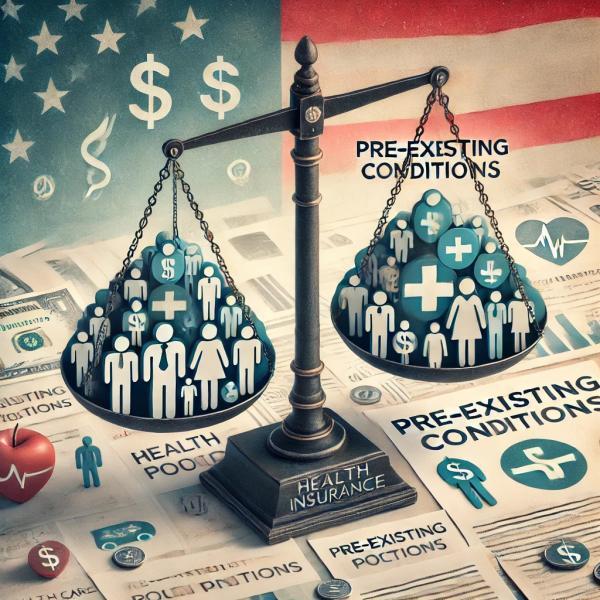
As STAT reports, GOP vice presidential candidate Senator JD Vance said the following on Meet the Press. DATE?
“In describing Trump’s health care plan, he started off by saying “you want to make sure that pre-existing coverage — conditions — are covered.” Then he said people should be sorted into risk pools, instead of a “one-size-fits-all approach that puts a lot of people into the same insurance pools.”
Evidently, Senator Vance's education did not include a thorough understanding of insurance. So, let’s discuss the fundamentals that apply irrespective of which side of the aisle you are seated.
Since its inception shortly after long-distance commerce appeared, insurance was meant to reduce your risk of a catastrophic event – be it the loss of your camel caravan, your ship full of New World tobacco and sugar, a car accident, or a health emergency. While it is presented as an agreement, it is a wager in which the insurance company bets you will be safe, and you bet you will not. When the insurance company wins, it gets the premium; when you win, the cost to cover the accident. Insurance is inherently a bet against yourself, a hedge.
For health insurance, there has been one particular change: we use health insurance to cover day-to-day medical costs, e.g., doctor’s appointments and medications, not just “catastrophes” like hospitalization and chronic illness. While that has altered what the bet covers, it has not changed the bet itself.
The wager
We purchase insurance to reduce our financial risk, and the price point for that reduction has to be far less than the risk itself. For the insurer, the price point has to be sufficient to cover your losses. In the ideal free market, both sides would be sufficiently informed that they would come to an economically rational price point. However, insurance is not a level playing field; it is tilted strongly towards insurers, primarily because of actuaries, individuals who analyze risk and establish premiums. Actuaries have been on the scene since the advent of insurance, and their prime lever is risk pooling.
Risk pools allow insurance companies to blend the higher costs of some payouts with the lower or nil cost of other payouts to achieve an affordable premium that includes something for the insurance company. [1] It is important to note that the pool size does not determine the cost of the premiums; only the distribution of high and low-cost payouts sets the premium.
Adverse selection
Adverse selection is quite a pejorative term, describing when a disproportionate share of costly, and in this instance, unhealthy, individuals are in the risk pool. However, it is a not uncommon concern, especially considering that from the individual viewpoint, with more significant health needs comes a great need for insurance, especially with more benefits. As more and more of the unhealthy jump into the risk pool, the cost of premiums must rise, and as those premiums rise, the well, who have little to gain and much to lose, hop out of the pool for a less expensive alternative.
Here is how the American Academy of Actuaries explains the situation:
“This process typically is referred to as a “premium spiral.” Avoiding such spirals requires minimizing adverse selection and instead attracting a broad base of healthy individuals, over which the costs of sick individuals can be spread. Attracting younger adults and healthier people of all ages ultimately will help keep premiums more affordable and stable for all members in the risk pool.”
Now, it should be clearer why Senator Vance’s thoughts conflict. While covering pre-existing conditions is ethically important and fiscally necessary, there is no ethically meaningful and fiscally responsible way to let everyone find a tailor-made risk pool. The numbers don’t work.
The Affordable Care Act (ACA)
The ACA requires using a single risk pool of all compliant plans within a State to calculate a premium, spreading the cost of unhealthy beneficiaries across everyone. It also allows the government to oppose Adam Smith’s “Invisible hand” to further equalize risk by payment transfers to those insurers based on the relative risk of their beneficiaries. [2]
Risk adjustments are vital in developing those payment transfers – protecting those with pre-existing conditions by providing affordable insurance and protecting healthier beneficiaries with lower premiums. Of course, as I have detailed elsewhere, no good deed goes unpunished, and risk adjustments are frequently used to game the system and increase insurance company payments – ensuring the playing field remains tilted in their favor.
If we strip away all of the pretense, all of the election drama, all of the sound bites and fury signaling nothing, financing health care comes down to two value propositions. Are we each to stand independent and allow a health care catastrophe of our making, say from overeating or smoking, or of someone else’s making, say from our involvement in a car accident, to leave us financially insolvent? Or are we our brother’s keeper?
At the heart of it, insurance is a balance between risk and reward—a bet we place on our health with the odds stacked in favor of the insurance companies. Covering pre-existing conditions is essential, but only a collective risk pool ensures we all share the load, allowing both the healthy and the sick to get coverage without sending premiums sky-high. Health care isn't a competition—it's a shared responsibility.
[1] Premiums pay projected claims, insurers’ administrative expenses, taxes, and profit. Most health policies must spend 85% of their premium on medical benefits, with the remaining 15% covering expenses, taxes, and profit.
[2] While best known for The Wealth of Nations, the Theory of Moral Sentiments provides a far more nuanced understanding of Smith’s beliefs. For example, “How selfish soever man may be supposed, there are evidently some principles in his nature, which interest him in the fortune of others, and render their happiness necessary to him, though he derives nothing from it except the pleasure of seeing it.”



